
National Music Museum 3350. Pochette, France, ca. 1650-1675.
This is by far the largest kit we
have found from the 17th century back, and we had to enlarge it by 7%
to make the numbers work. It is still significantly shorter and
very much narrower than any standard fiddle.
As usual, to start an instrument one needs to design the instrument form and create templates. So that's where we started.

The templates ready to be glued to the masonite. Can't create a 'production' model without templates.
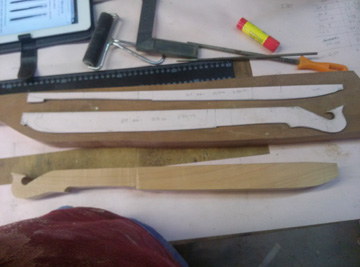
Rough cut from a block of hard cherry. Side view with templates.
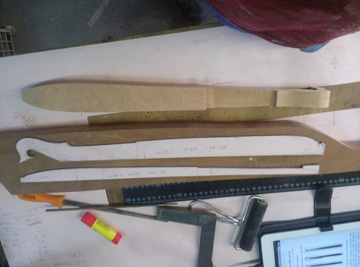
Rough cut, bottom view.
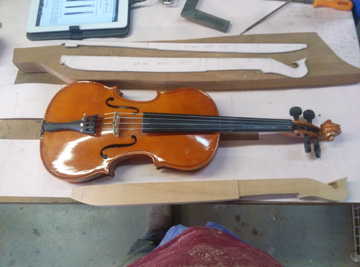
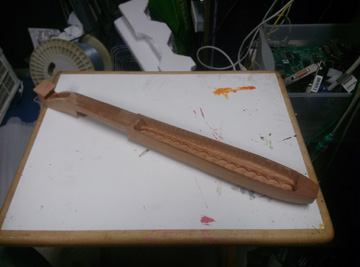
Starting to rough in the form and hollow the body. Modified forstner bits used in the pegbox and body cavity. Now to a spoon plane and some scrapers. This is such a standard art of building these instruments, pictures are boring. So I will move right along to an interesting part...
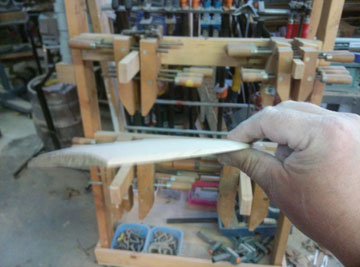
THE SOUNDBOARD!!!! This is a departure from the traditional rebec, in that it is a lightly carved top. Still no bracing or soundpost, no bass bar, but much more structurally rigid. Add to the fact that it is only a couple of inches wide, and it can be made very thin to make up for some of the sound volume lost by simply having such a small surface area. Here is the blank, cut from a AAA violin carpathian red spruce soundboard block and shaped on the top.
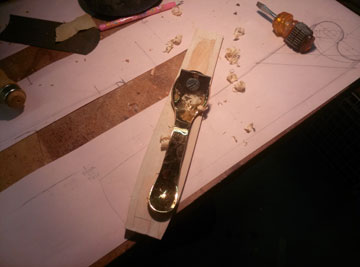
A spoon plane to work down the inside of the soundboard.
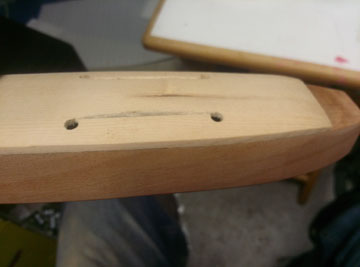
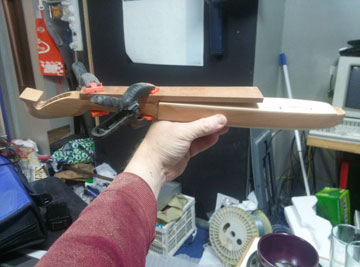
With the top on, next comes the fingerboard. Brazillian Cherry. The simple scroll has been hollowed. Just a bit of shaping on the fingerboard, a nut, saddle, and bridge and some tuning pegs, and off we go.
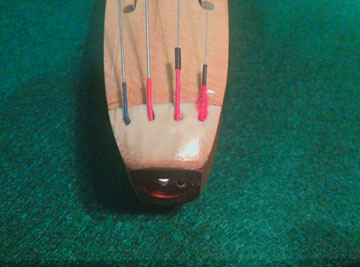
The tail end of the pochette. 4 holes drilled through the body wood and the saddle, a circular recess bored in the tail of the instrument. SInce the instrument is so small, a tailpiece, while possible, would not have allowed the proper afterlength of the strings, so I decided to borrow this method from an instrument shown on the National Music Museum site.
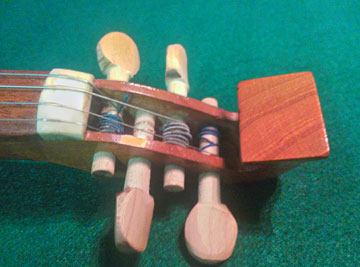
The scroll and tuning pegs, and the antler nut. Nothing surprising here.

Here is the bridge. Carved in a traditional manner from hard maple with the medullary rays showing as dots on the face of the bridge. The feet straddle the c-hole cuts, but the bridge is fitted in such a way that most of the force is on the section of soundboard between the cuts. Again, no bracing, no sound post, nothing except a small curve to keep the soundboard from falling in.
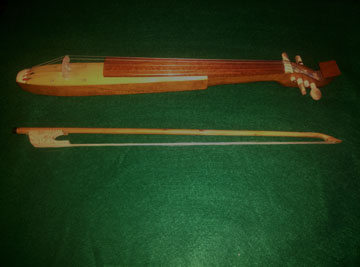
Here is the finished instrument. A dozen hand-rubbed coats of oil as a finish, without a final compound or pumice polish. It has a very sweet and focused sound, though lacking a bit in volume it can still play usefully in a small room. It could very easily be used to correct a single player in an orchestra without disturbing the rest, or to play in a parlor while teaching dance. The bow is Yew, with a clip-in sycamore frog and white Siberian mare hair. It is just 1/4 inch less than the finished length of the instrument.
As usual, to start an instrument one needs to design the instrument form and create templates. So that's where we started.

The templates ready to be glued to the masonite. Can't create a 'production' model without templates.

Rough cut from a block of hard cherry. Side view with templates.

Rough cut, bottom view.

Size comparison with a standard
full-size violin. The instrument will be little larger than it is
in rough block form.

Starting to rough in the form and hollow the body. Modified forstner bits used in the pegbox and body cavity. Now to a spoon plane and some scrapers. This is such a standard art of building these instruments, pictures are boring. So I will move right along to an interesting part...

THE SOUNDBOARD!!!! This is a departure from the traditional rebec, in that it is a lightly carved top. Still no bracing or soundpost, no bass bar, but much more structurally rigid. Add to the fact that it is only a couple of inches wide, and it can be made very thin to make up for some of the sound volume lost by simply having such a small surface area. Here is the blank, cut from a AAA violin carpathian red spruce soundboard block and shaped on the top.

A spoon plane to work down the inside of the soundboard.

Add some c-holes and glue it to the
body, and VOILA!!!! It's
starting to look like an instrument.

With the top on, next comes the fingerboard. Brazillian Cherry. The simple scroll has been hollowed. Just a bit of shaping on the fingerboard, a nut, saddle, and bridge and some tuning pegs, and off we go.

The tail end of the pochette. 4 holes drilled through the body wood and the saddle, a circular recess bored in the tail of the instrument. SInce the instrument is so small, a tailpiece, while possible, would not have allowed the proper afterlength of the strings, so I decided to borrow this method from an instrument shown on the National Music Museum site.

The scroll and tuning pegs, and the antler nut. Nothing surprising here.

Here is the bridge. Carved in a traditional manner from hard maple with the medullary rays showing as dots on the face of the bridge. The feet straddle the c-hole cuts, but the bridge is fitted in such a way that most of the force is on the section of soundboard between the cuts. Again, no bracing, no sound post, nothing except a small curve to keep the soundboard from falling in.

Here is the finished instrument. A dozen hand-rubbed coats of oil as a finish, without a final compound or pumice polish. It has a very sweet and focused sound, though lacking a bit in volume it can still play usefully in a small room. It could very easily be used to correct a single player in an orchestra without disturbing the rest, or to play in a parlor while teaching dance. The bow is Yew, with a clip-in sycamore frog and white Siberian mare hair. It is just 1/4 inch less than the finished length of the instrument.
